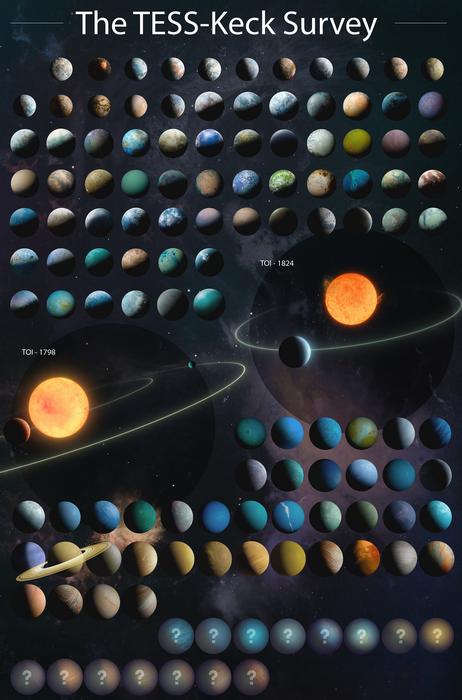While thousands of planets have been discovered around other stars, relatively little is known about them. A NASA catalog featuring 126 exotic, newly discovered worlds includes detailed measurements that allow for comparisons with our own solar system.

Credit: W. M. Keck Observatory/Adam Makarenko
While thousands of planets have been discovered around other stars, relatively little is known about them. A NASA catalog featuring 126 exotic, newly discovered worlds includes detailed measurements that allow for comparisons with our own solar system.
The catalog details a fascinating mix of planet types beyond our solar system, from rare worlds with extreme environments to ones that could possibly support life.
The planets were analyzed by a large, international team of scientists using NASA’s Transiting Exoplanet Survey Satellite (TESS) in collaboration with the W.M. Keck Observatory on Maunakea, Hawai’i. They are described in today’s edition of The Astrophysical Journal Supplement.
“Relatively few of the previously known exoplanets have a measurement of both the mass and the radius. The combination of these measurements tell us what the planets could be made of and how they formed,” said Stephen Kane, UC Riverside astrophysicist and principal investigator of the TESS-Keck Survey.
“With this information, we can begin to answer questions about where our solar system fits in to the grand tapestry of other planetary systems,” Kane said.
The research team spent three years developing the catalog. They analyzed more than 13,000 radial velocity (RV) measurements to calculate the masses of 120 confirmed planets, plus six candidate planets, spread out over the northern sky.
Though the planets themselves aren’t visible, they do have a visible effect. As they orbit, the planets tug on their host stars, causing them to “wobble.” When the star moves toward a telescope, its visible light turns slightly bluer; when it moves away from us, the light shifts slightly redder.
This is much like how sound behaves. Due to the Doppler effect, a fire truck’s siren gets higher-pitched as it travels closer and sounds lower-pitched as it drives farther away.
“These RV measurements let astronomers detect and learn the properties of these exoplanetary systems. When we see a star wobbling regularly back and forth, we can infer the presence of an orbiting planet and measure the planet’s mass,” said Ian Crossfield, University of Kansas astrophysicist and catalog co-author.
Several planets in the TESS-Keck Survey stand out as touchstones for deepening astronomers’ understanding of the diverse ways planets form and evolve.
A related survey paper authored by UCR graduate student Michelle Hill announces the discovery of two new planets orbiting a star like our sun. The first is a “sub-Saturn” planet with a mass and radius that are between those of Neptune and Saturn.
“There is ongoing debate about whether sub-Saturn planets are truly rare, or if we are just bad at finding planets like these,” Hill said. “So, this planet, TOI-1386 b, is an important addition to this demographic of planets.”
TOI-1386 b only takes 26 days to orbit its star. Meanwhile its neighbor, a planet with a mass close to that of Saturn, takes 227-days to orbit the same star.
Another survey paper authored by UCR graduate student Daria Pidhorodetska describes a planet about half the size of Neptune that takes a mere 19 days to orbit its star, which is much like our Sun.
“Planets smaller than Neptune but larger than Earth are the most prevalent worlds in our galaxy, yet they are absent from our own Solar System. Each time a new one is discovered, we are reminded of how diverse our Universe is, and that our existence in the cosmos may be more unique than we can understand,” Pidhorodetska said.
There are a lot of stars that are not similar to our sun. If scientists want to make apt comparisons between our world and others, they need to find stars of a similar age, size, and mass. “Then we can do apples-to-apples comparisons,” Kane said. “That’s the exciting part of the papers produced by Michelle and Daria, because they allow for this.”
Planets with even more extreme, ultra-short orbits around stars unlike our sun are also detailed in the catalog. One is so close to its orange dwarf star it completes orbit in less than 12 hours.
“TOI-1798 c orbits its star so quickly that one year on this planet lasts less than half a day on Earth. Because of their proximity to their host stars, planets like this one are also ultra hot — receiving more than 3,000 times the radiation that Earth receives from the sun,” said Alex Polanski, University of Kansas physics and astronomy graduate student and lead author of the catalog paper.
“Existing in this extreme environment means that this planet has likely lost any atmosphere that it initially formed,” Polanski said.
Ultimately, this new catalog represents a major contribution both to NASA’s TESS mission, and toward answering the question of whether other planets are capable of hosting life as we know it.
“Are we unusual? The jury is still out on that one, but our new mass catalog represents a major step toward answering that question,” Kane said.
Journal
The Astrophysical Journal
Article Publication Date
23-May-2024



